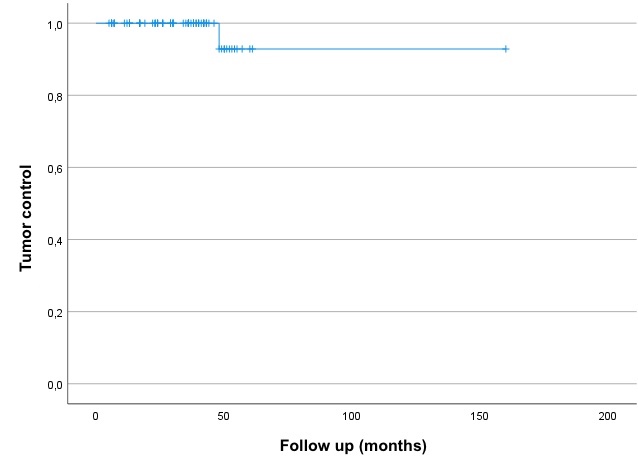Clinical outcomes after radiosurgery in vestibular schwannomas
Beatriz Vázquez Barreiro,
Spain
PO-1132
Abstract
Clinical outcomes after radiosurgery in vestibular schwannomas
Authors: Beatriz Vázquez Barreiro1, Fernando López Campos2, María Luisa Vázquez de la Torre González1, Manuel Caeiro Muñoz3, Virginia Ochagavía Galilea3, Iñigo Nieto Regueira1, María Alejandra Naranjo Sánchez1, Mónica Gonzalez Rodríguez1, Eva Azevedo González4, Julio Vázquez Rodríguez5, Alicia González Pose5, Víctor Muñoz Garzón1
1Hospital Meixoeiro (CHUVI), Radiation Oncology, Vigo, Spain; 2Hospital Universitario Ramón y Cajal, Radiation Oncology, Madrid, Spain; 3Hosptital Meixoeiro (CHUVI), Radiation Oncology, Vigo, Spain; 4Hospital Álvaro Cunqueiro (CHUVI), Neurosurgery, Vigo, Spain; 5Hospital Meixoeiro (CHUVI), Medical Physics, Vigo, Spain
Show Affiliations
Hide Affiliations
Purpose or Objective
To assess long-term local control of VS after SRS. Secondary outcomes were toxicity and hearing preservation as well as its association with clinical or SRS treatment factors.
Material and Methods
We retrospectively evaluated patients who underwent LINAC-based SRS for VS between 2015 to 2020. Patients were followed with clinical visits and MRI scans every 6 months for the first 3 years, then annually. Audiometry was performed before and after SRS treatment. Hearing preservation was analyzed in terms of maintenance of Gardner-Robertson grade and toxicity was reported according to the Common Terminology Criteria for Adverse Events (CTCAE)v4.0.
Results
78 patients with unilateral VS treated with SRS in our institution were included. Median tumor volume was 1,35cc (0,1-12,9 cc). Median radiation dose was 25Gy (12-30Gy). With a median follow up of 36 months, 3-year tumor control rate was 98,7%. 12 patients (15,38%) maintained serviceable hearing (Gardner- Robertson scale I-II) after SRS. Functional hearing preservation rate amounted to 90,2% 1 year after treatment and 69% after 3 years. Most frequent non- auditory complication was vertigo grade 1, presented in 16 patients (20,51%). There were no grade III-V complications (CTCAE). No clinical or SRS treatment factors were significantly related to hearing preservation and/or toxicity.


Conclusion
SRS can achieve high rates of long-term tumor control and acceptable hearing preservation with low rates of severe toxicity.